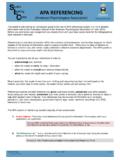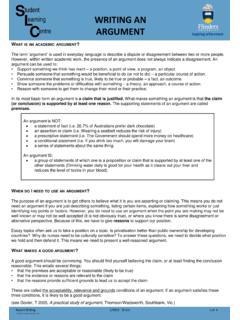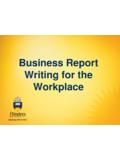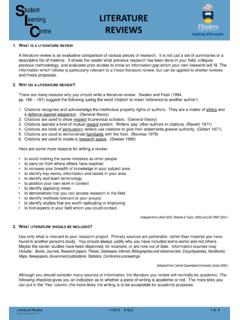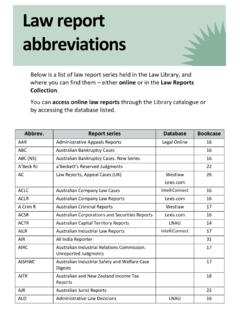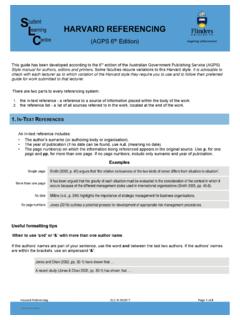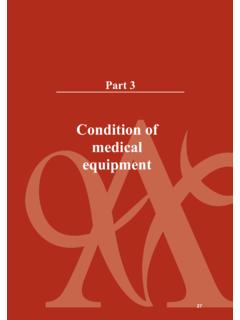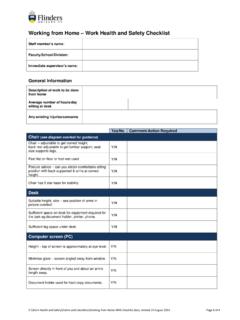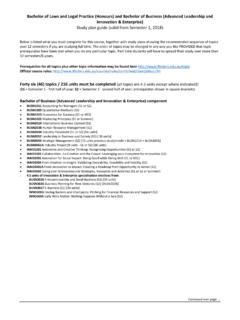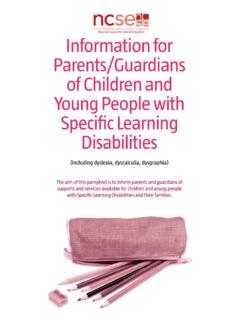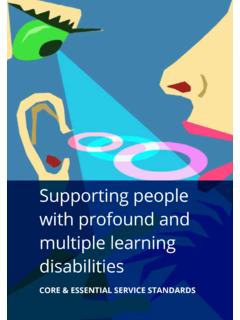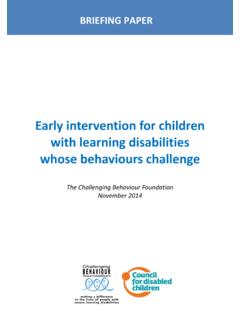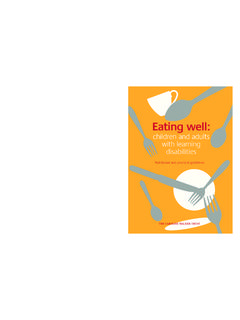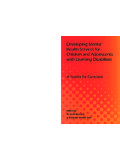Transcription of Understanding everyday money skills for young …
1 Understanding everyday money skills for young people with disabilities Ann-Louise Hordacre October 2016. Understanding everyday money skills for young people with disabilities Australian Industrial Transformation Institute Flinders Business School Faculty of Social & Behavioural Sciences Flinders University of South Australia 1284 South Road Clovelly Park South Australia 5042. Published 2016. ISBN: 978-0-9941906-9-7. URL: CAT: AITI201605. Suggested citation: Hordacre AL. 2016. Understanding everyday money skills for young people with disabilities . Adelaide: Australian Industrial Transformation Institute, Flinders University of South Australia. This research was supported by a grant from Financial Literacy Australia. Financial Literacy Australian supports innovative research and projects that give Australians the Knowledge, skills and tools necessary to reach their financial goals. AITI would also like to acknowledge the contributions and support from The Wyatt Trust and Bedford-Phoenix.
2 The Australian Industrial Transformation Institute (AITI) has taken care to ensure the material presented in this report is accurate and correct. However, AITI does not guarantee and accepts no legal liability or responsibility connected to the use or interpretation of data or material contained in this report. Contents EXECUTIVE SUMMARY .. III. FINANCIAL LITERACY ..III. DISABILITY ..III. FINANCIAL LITERACY EDUCATION FOR YOUTH WITH disabilities .. IV. FRAMEWORK AND APPROACHES FOR SPECIAL NEEDS IV. DEVELOPING A FINANCIAL LITERACY PROGRAM FOR YOUTH WITH V. ASSESSMENT .. V. 1 FINANCIAL LITERACY .. 1. 2 DISABILITY .. 5. NATIONAL DISABILITY INSURANCE SCHEME .. 6. 3 FINANCIAL LITERACY EDUCATION FOR YOUTH WITH disabilities .. 7. 4 FRAMEWORK AND APPROACHES FOR SPECIAL NEEDS TEACHING .. 9. UNIVERSAL DESIGN FOR LEARNING FRAMEWORK .. 9. Multiple means of representation .. 9. Multiple means of action and expression .. 9. Multiple means of engagement.
3 10. LEARNING METHODS .. 10. Project- and problem-based learning .. 10. In-vivo learning .. 11. Differentiated instruction .. 11. 5 DEVELOPING A FINANCIAL LITERACY PROGRAM FOR YOUTH WITH disabilities .. 13. CORE COMPETENCIES .. 15. Recognising and counting money .. 16. Valuing money .. 16. Safety with money .. 17. 6 ASSESSMENT .. 18. REFERENCES .. 20. APPENDIX 1. FINANCIAL LITERACY RESOURCES .. 22. 22. SOURCE .. 22. money /COMMONWEALTH-BANK-FOUNDATION/FINAN CIAL-LITERACY-TEACHING- .. 22.. 22.. 22. List of Tables TABLE 1: OECD-PISA FINANCIAL LITERACY PROFICIENCY LEVELS .. 4. TABLE 2: DIFFERENCES BETWEEN PROJECT- AND PROBLEM-BASED LEARNING .. 11. TABLE 3: DIFFERENCE BETWEEN LOW AND HIGH 12. TABLE 4: KEY FINANANCIAL LITERACY COMPETENCIES FOR YOUTH WITH disabilities .. 14. i AITI (2016). List of Figures FIGURE 1: OVERALL ARCHITECTURE OF THE OECD/INFE CORE COMPETENCIES FRAMEWORK .. 3. ii AITI (2016). Executive Summary Financial literacy Financial literacy is commonly recognised as referring to the skills , knowledge and confidence that support individuals making informed and effective decisions about the use and management of their money across a range of contexts.
4 Financial literacy is not static but grows and expands throughout life. It requires the integration of basic maths, personal experience, attitudes and values along with the use of both cognitive and practical financial literacy skills . And critically, it requires confidence to ask questions, seek advice and make decisions (OECD, 2013). Increasingly countries, including Australia, have become concerned about the level of financial literacy evident in their populations (Financial Literacy Foundation, 2007; OECD, 2013; Orton, 2007; Worthington, 2013). Barriers to Understanding and accessing financial services are experienced by many. However, people who are socially and economically disadvantaged and those with literacy and numeracy difficulties are likely to face the biggest hurdles with Understanding and access (Conroy & O'Leary, 2005; SEDI, 2008). Poor financial literacy, financial hardship and financial exclusion are often intertwined with social exclusion.
5 However, improving financial literacy can positively impact individuals through the promotion of financial resilience, and by improving financial decision making, asset building and social engagement (Drew, 2013; Mittapalli, 2009). It is recognised that financial literacy skills are learnt in a range of ways (OECD/INFE, 2015). Early learning often comes from parents and other family members. Peer to peer learning also contributes to general awareness and experience with financial services and products, as does specific education within schools and school savings programs. With the later having the additional benefit of providing a consistent program of learning for students from a range of economic backgrounds thereby reducing gaps and inequity in financial literacy for those from lower socio-economic backgrounds. Disability There is no one definition of disability1,. However, the United Nations Convention on the Rights of Persons with disabilities includes the following definition: Persons with disabilities include those who have long-term physical, mental, intellectual or sensory impairments which in interaction with various barriers may hinder their full and effective participation in society on an equal basis with others.
6 (United Nations, 2006). The UN Convention seeks to recognise the rights of disabled persons to participate in the social, cultural, political and public life on an equal basis to other members of society. Amongst other things, it includes equitable access and opportunities, the right to respect and freedom from exploitation, discrimination and abuse. The National Disability Insurance Scheme (NDIS) has been established as a national social insurance scheme providing fairer support to individuals with severe and profound disabilities and their carers. Under the NDIS people with disabilities and/or their carers will have choice and decision making ability - they can choose their own providers, determine the appropriate package of services and direct funding to areas of individual need (self-directed funding). Participants will receive monthly statements detailing the money received and spent. It is critical that those in 1 For the purposes of this project, the term disability' is used to refer to intellectual and multiple disabilities .
7 Iii AITI (2016). control of this resource have the financial literacy to adequately and appropriately control it. However, this is often not the case. Financial education opportunities for people with disabilities have not always been equitable resulting in the financial literacy of many people with disabilities being suboptimal (Lombe, Huang, Putnam, & Cooney, 2008). Financial literacy education for youth with disabilities Teacher's aids or curriculum targeting financial literacy provide limited if any examples of financial literacy training for young people with disabilities , often meaning individual teachers are left to modify the mainstream curriculum on a case-by-case (or school-by-school) basis with the adapted curriculum not always subject to wider review or evaluation. In effect, although some education is available in primary and secondary schools relating to financial literacy for young people with special needs, in many cases parents continue to play a key role in supporting and informally educating their children about money and teaching them about the value of money and responsible financial management (Mittapalli, 2009; The money Advice Service, 2013).
8 The transitional phase when youth with disabilities transfer from school to the workforce poses many challenges. Critical to this transition is the ability to manage new financial responsibilities relevant to employment or other income sources and associated spending. It is in the transition to work where financial literacy skills and the ability to budget income against expenditure is tested directly. Framework and approaches for special needs teaching Universal design for learning (UDL) was initially developed by David Rose in the 1990s as a flexible approach to accommodate individual learning differences. As such it is a valuable framework for teaching young people with disabilities . This framework recommends designing curriculum that provides multiple means of representation, action and expression and engagement (CAST, 2011; Forlin, Chambers, Loreman, Deppler, & Sharma, 2013). Learners differ in how they perceive and understand information.
9 The use of different representation (text, visual and auditory) not only serves to support those who learn in different ways but facilitates learning as it enhances connections between concepts (CAST, 2011). Options should be provided for learning through physical action, expression and communication and executive function. These approaches provide alternate ways for learners to demonstrate what they know. It is important to use multiple methods for engaging and maintaining learner interest. Options and choice should be available for the type and level of task challenges, motivations and rewards. Activities need to be authentic, relevant and meaningful to ensure learner engagement. Project- and problem-based learning (both referred to as PBL) approaches engage students in solving open-ended real world problems (Edutopia, 2015; Krajcik & Blumenfeld, 2006). They share a number of characteristics, both are focused on open-ended questions or tasks and provide an authentic real world experience which includes applying skills to tasks.
10 Differentiated instruction accommodates the diverse academic needs of students while aiming to achieve equivalent learning outcomes. As students have a range of different learning styles it is therefore best, wherever possible, to target learning activities to suit individuals. Key learning processes include activating the learning relating to a new topic to things previously learned. This approach also encourages explanations about the purpose of the material and what can be achieved once the material is learnt. iv AITI (2016). Developing a financial literacy program for youth with disabilities A financial literacy program for youth with disabilities needs to draw on standards developed for their peers, while recognising their differential capability level - both as individuals and as a group. Numeracy is the critical core skill for Understanding and using money and financial services (National Adult Literacy Agency, 2015).
